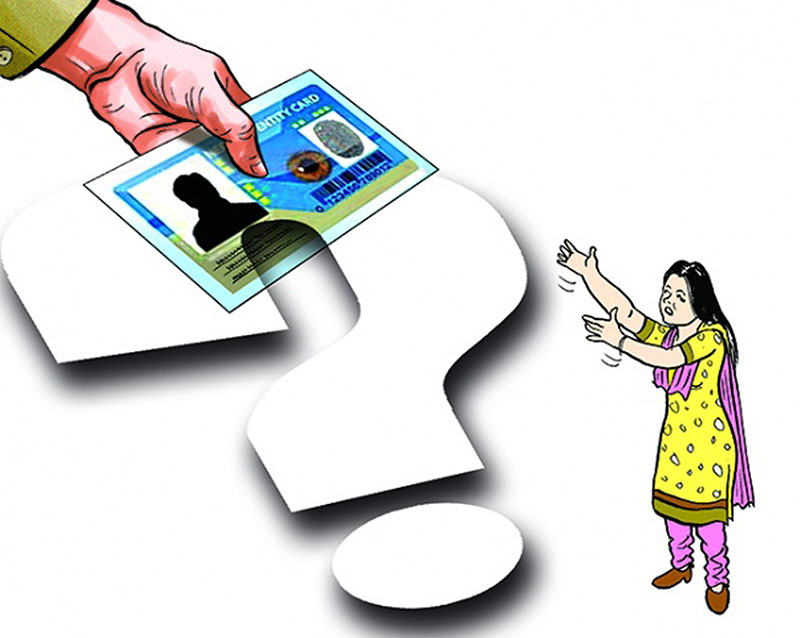
OR

More than issuing the cards, their use could be more problematic. We will have to have special card readers in almost all public places
After a delay of almost five years, the National ID Management Center (NIDMC) has finally selected a bidder to distribute the much-awaited national identification cards. Of the six bidders—three from France, one from Germany, one from Sri Lanka and one from Malaysia—a French company named Morhpo has won the bid. As per the contract, the company will now have to issue 112,000 cards as a part of a pilot project to issue cards that will have all the necessary demographic information of Nepali citizens. These cards will ultimately replace the existing citizenship cards.
The exact reason for the five-year delay is not known. One would like to assume that various government agencies have utilized the time in deciding the right ‘design’ of the card and moreover ensuring that the information stored in the system is fully secure. The parliamentary Public Accounts Committee had expressed its concern over awarding the contract to the French company, since the company was also involved in a similar project in India. This concern ought to have been resolved by now. While skeptics do see a risk in allowing a foreign party to conduct this project, Nepal also does not have much choice.
So far, very less has been shared with the general public. The responsible agency hasn’t said much except that it will try to resolve all issues. That will be easier said than done since there is no precedence of a single, all-purpose card, even in countries like the US and the UK.
We already have a system that issues different cards which helps us identify ourselves. The PAN or public account number, passport, citizenship, driving license are few of the examples. A big challenge in coming up with a yet another card will be in figuring out what exactly it does and what it does not do.
The primary purpose of such a card is to ensure that the state can reach people directly, cutting the bureaucratic hurdles. As has been seen in case of Aadhar Card, a Unique Identification Card, optionally available to valid citizens of India, the beneficiaries have been able to receive government grant and state help directly through their Aadhar card. Prior to Aadhar card, India had no credible information on whether its aid actually reached targeted population. India today, with its more than 100 crore ID cards, claims that the dream of reaching the poor and the needy via use of technology has been fulfilled. Today, the payment of social schemes like NREGA (that ensures guaranteed work) is done using the card and there is 100 percent guarantee that the payment reaches actual NREGA workers.
Therefore, in a country like ours with divergent population and often difficult access to state machinery, it might be a good idea to have everyone covered by a system that allows the state to identify them, their needs and to formulate effective policies. More important, with national identification number, states can easily monitor the effectiveness of the policies implemented.
Often, the reason for denial of identification has been attributed to non-nationals acquiring national identification or legitimacy. It’s a tragedy that in the name of ‘sovereignty’ and ‘nationalism’, many governments have denied citizenship to rightful citizens. Nepal is no exception.
It’s obvious that a country that does not recognize the existence of its people will fail miserably is assessing their needs as well. The NIDMC states on its website these new biometric cards will have two thumb prints and iris scans of every citizen. And these cards are going to be mandatory.
Aadhar similarly uses biometric information of two iris and ten finger prints.
Given our track record, we know that most of our projects lose their impact as major chunk of the budget is spent in administrative overheads. So only a small portion of the budget reaches the intended beneficiaries. Secondly, this could help deal with cases of citizens who do not have any identification. With technology, internet and large and cheap systems available to store and process data, coming up with such a system is possible, even easy.
Hence, to design a system to accommodate a maximum of 37.2 million records won’t be that hard. Facebook, Twitter and Google have already shown how. We can leverage our second-mover advantage. We do not have to reinvent the wheel.
There are still challenges though. If at all there is lack of anything, there is clear lack of conviction. For example, it has taken fortuitous five-long-years just to decide whether to go for national identification card. The official website of NIMDC looks stupid for it shares little information regarding its end goals. Rather, it assumes or envisages a system of distribution of national identification cards that will take care of everything, starting with driving licenses to property papers and even serve as a replacement for national citizenship cards. In several countries, the challenge has been to store as little data as they can make do with. It’s also worth noting that the Indian government was forced to make Aadhar cards voluntary after the intervention by its Supreme Court. The original plan was to make it compulsory for all citizens.
The fact that Indian government appointed Nandan Nilekani as the chairman of UADAI, the issuer of Aadhar cards, giving him the status of a cabinet minister, highlights the importance India placed in developing the world’s largest biometric project. Nilekani had the success of Infosys under his belt. But we know little about the competence of national ID team.
But the biggest challenge would be maintaining the infrastructure. According to the agency, “the National ID Card will help to provide prompt and quality service to the citizens at minimum cost, to maintain good governance and to control crime in the society.”
The problem is, we do not know the ‘how’. Also, more than issuing the cards, their use could be more problematic. Special cards definitely mean we will have to have card readers in almost all public places.
A recent news report in this newspaper had a 45-year-old widow regretting the loss of her husband in last year’s earthquakes. She had managed to overcome the tragedy but now, with her husband gone, she has been rendered ‘identity-less’ as well. She cannot make a claim on government aid to rebuild her home. One identification number stored somewhere could possibly do the trick—all you need is a number to authenticate yourself.
hiteshkarki@gmail.com
You May Like This

In the name of faith
Everybody likes to travel for different reasons and sometimes the motive isn’t only some fun time at the beach, or... Read More...

Julia Roberts to make the leap to TV in new limited series
Things are about to get very different for Julia Roberts, as the longtime film star transitions to television in a... Read More...

Faith in miracles results in loss of life
DANG, Nov 9: When Hira Mani (name changed), a local of Satabariya in Dang district, suffered a knee injury from a... Read More...







Just In
- NRB to provide collateral-free loans to foreign employment seekers
- NEB to publish Grade 12 results next week
- Body handover begins; Relatives remain dissatisfied with insurance, compensation amount
- NC defers its plan to join Koshi govt
- NRB to review microfinance loan interest rate
- 134 dead in floods and landslides since onset of monsoon this year
- Mahakali Irrigation Project sees only 22 percent physical progress in 18 years
- Singapore now holds world's most powerful passport; Nepal stays at 98th












Leave A Comment